
Harness racing is a form of horse racing in which the horses race at a specific gait. They usually pull a two-wheeled cart called a sulky, or spider, occupied by a driver. In Europe, and less frequently in Australia and New Zealand, races with jockeys riding directly on saddled trotters are also conducted.

The Standardbred is an American horse breed best known for its ability in harness racing, where members of the breed compete at either a trot or pace. Developed in North America, the Standardbred is recognized worldwide, and the breed can trace its bloodlines to 18th-century England. They are solid, well-built horses with good dispositions. In addition to harness racing, the Standardbred is used for a variety of equestrian activities, including horse shows and pleasure riding, particularly in the Midwestern and Eastern United States and in Southern Ontario.

Horses can use various gaits during locomotion across solid ground, either naturally or as a result of specialized training by humans.

The Morgan horse is one of the earliest horse breeds developed in the United States. Tracing back to the foundation sire Figure, later named Justin Morgan after his best-known owner, Morgans served many roles in 19th-century American history, being used as coach horses and for harness racing, as general riding animals, and as cavalry horses during the American Civil War on both sides of the conflict. Morgans have influenced other major American breeds, including the American Quarter Horse, Tennessee Walking Horse and the Standardbred. During the 19th and 20th centuries, they were exported to other countries, including England, where a Morgan stallion influenced the breeding of the Hackney horse. In 1907, the US Department of Agriculture established the US Morgan Horse Farm near Middlebury, Vermont for the purpose of perpetuating and improving the Morgan breed; the farm was later transferred to the University of Vermont.The first breed registry was established in 1909, and since then many organizations in the US, Europe and Oceania have developed. There were estimated to be over 175,000 Morgan horses worldwide in 2005.

The American Saddlebred is a horse breed from the United States. This breed is referred to as the "Horse America Made". Descended from riding-type horses bred at the time of the American Revolution, the American Saddlebred includes the Narragansett Pacer, Canadian Pacer, Morgan and Thoroughbred among its ancestors. Developed into its modern type in Kentucky, it was once known as the "Kentucky Saddler", and used extensively as an officer's mount in the American Civil War. In 1891, a breed registry was formed in the United States. Throughout the 20th century, the breed's popularity continued to grow in the United States, and exports began to South Africa and Great Britain. Since the formation of the US registry, almost 250,000 American Saddlebreds have been registered, and can now be found around the world, with separate breed registries established in Great Britain, Australia, continental Europe, and southern Africa.

A horse show is a judged exhibition of horses and ponies. Many different horse breeds and equestrian disciplines hold competitions worldwide, from local to the international levels. Most horse shows run from one to three days, sometimes longer for major, all-breed events or national and international championships in a given discipline or breed. Most shows consist of a series of different performances, called classes, wherein a group of horses with similar training or characteristics compete against one another for awards and, often, prize money.

The Tennessee Walking Horse or Tennessee Walker is a breed of gaited horse known for its unique four-beat running-walk and flashy movement. It was originally developed in the southern United States for use on farms and plantations. It is a popular riding horse due to its calm disposition, smooth gaits and sure-footedness. The Tennessee Walking Horse is often seen in the show ring, but is also popular as a pleasure and trail riding horse using both English and Western equipment. Tennessee Walkers are also seen in movies, television shows and other performances.
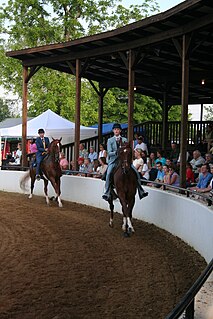
"English pleasure" is the generic term for a number of different English riding classes seen at horse shows in the United States, where the horse is ridden in either hunt seat or saddle seat tack.
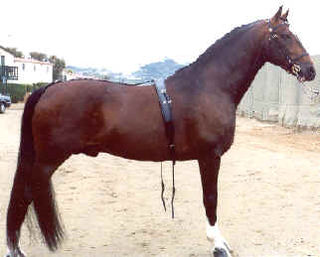
The Hackney is a recognized breed of horse that was developed in Great Britain. In recent decades, the breeding of the Hackney has been directed toward producing horses that are ideal for carriage driving. They are an elegant high stepping breed of carriage horse that is popular for showing in harness events. Hackneys possess good stamina, and are capable of trotting at high speed for extended periods of time.

The Hackney pony is a breed of pony closely related to the Hackney horse. Originally bred to pull carriages, they are used today primarily as show ponies. The breed does not have its own stud book, but shares one with the Hackney horse in all countries that have an official Hackney Stud Book Registry.

The Dole Gudbrandsdal, Dølahest or Dole is a draft- and harness-type horse from Norway. The Dole Trotter is alternately considered a subtype of the Dole Gudbrandsdal and a separate breed; it is also considered a part of the Coldblood trotter type. The Dole Gudbrandsdal is a small draft horse, known for its pulling power and agility, while the Dole Trotter is a smaller, faster horse used for harness racing; the two types are commonly interbred. Both types are strictly critiqued before entry into the studbook, which has over time resulted in an improvement in the breed type. The Dole is originally from the Gudbrandsdal Valley, and is probably descended in part from the Friesian horse. Over time the breed has had Thoroughbred, Arabian and other blood added in, especially during the creation of the Dole Trotter in the 19th century. The first studbook was created in 1941, and the current breed association was formed in 1947. Although originally used mainly as a pack horse, today the heavier Dole type is used mainly for agricultural purposes. The Dole Gudbrandsdal been crossed with other breeds to develop horses for harness racing and riding.
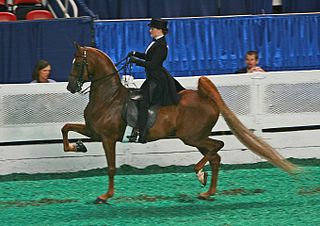
Saddle seat is a style of horse riding within the category of English riding that is designed to show off the high action of certain horse breeds. The style developed into its modern form in the United States, and is also seen in Canada and South Africa. To a much lesser extent, it is ridden with American action horse breeds in Europe and Australia. The horse breeds mainly used for this flashy style are typically the showy Morgan Horse, and the high stepping American Saddlebred.

Hambletonian 10, or Rysdyk's Hambletonian, was an American trotter and a founding sire of the Standardbred horse breed. The stallion was born in Sugar Loaf, New York on 5 May 1849. Hambletonian has been inducted into the Immortals category of the Harness Racing Hall of Fame.
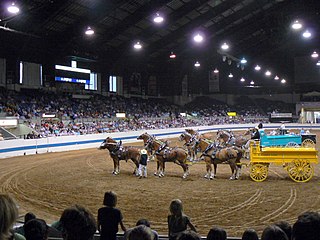
Draft horse showing refers to horse shows exclusively for horses of the draft horse breeds. In North America, though a small number of draft horses are also shown under saddle, the term "Draft horse showing" refers to a specific horse show competition that primarily features driving exhibitors presenting their horses to be judged in harness. Worldwide, some draft horse shows also feature riding classes.

Halter is a type of horse show class where horses are shown "in hand," meaning that they are led, not ridden, and are judged on their conformation and suitability as breeding stock. Depending on breed and geographic region, such events may be called "Halter," "In-Hand," "Breeding," "Model," or "Conformation" classes.

Driving, when applied to horses, ponies, mules, or donkeys, is a broad term for hitching equines to a wagon, carriage, cart, sleigh, or other horse-drawn vehicle by means of a harness and working them in this way. It encompasses a wide range of activities from pleasure driving, to harness racing, to farm work, horse shows, and even international combined driving.

Roadster is a type of driving competition for horses and ponies where the horse and exhibitor appear in equipment similar to that used in harness racing. It is derived from the historical use of certain horses hitched to light carts that traveled quickly from one place to another, often racing on ordinary dirt roads, hence the name. The term is also used to describe the horse used for such competition. Horses pull a light sulky and drivers wear racing silks. However, the exhibitors do not race. Instead, they perform in an arena at horse shows at trotting gaits that include a slow jog, a medium speed "road gait," and a rapid and long-strided but controlled trot referred to as showing "at speed." Animals are evaluated on performance and manners.
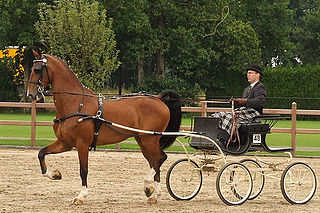
The Dutch Harness Horse, or Tuigpaard, is a warmblood breed of fine driving horse that has been developed in the Netherlands since the end of World War II. Their studbook is kept by the Koninklijk Warmbloed Paardenstamboek Nederland or KWPN. The breed is based on the native Groningen and Gelderland horses, which were formerly indispensable in agriculture and transportation services. Strict selection procedures and a clear breeding aim enabled breeders to produce a refined, high-stepping horse within a few decades. While with 40 sires and fewer than 2,000 broodmares the population is not large, Dutch Harness Horses are highly recognizable. In the past few years, a handful have come to North America, where they are used as sport horses and saddle seat horses alike.
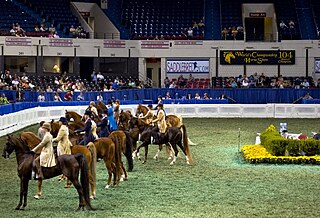
The World's Championship Horse Show, held at the Kentucky State Fairgrounds in Louisville, Kentucky, in Freedom Hall, is a large horse show that includes the American Saddlebred, Hackney pony, and Standardbred breeds. It is usually held annually in late August, coinciding with the dates of the Kentucky State Fair and in the middle of the show season for the three breeds. Any horse or rider who wins there earns the title of World's Champion, and a second-place finish is identified with a Reserve World's Championship title. In addition to the WC and RWC titles, a horse can also earn the World's Grand Championship (WGC) or World's Championship of Champions (WCC) title. The winner of a championship class which requires a qualifier is given one of these titles.

This is a basic glossary of equestrian terms that includes both technical terminology and jargon developed over the centuries for horses and other equidae, as well as various horse-related concepts. Where noted, some terms are used only in American English (US), only in British English (UK), or are regional to a particular part of the world, such as Australia (AU).





















